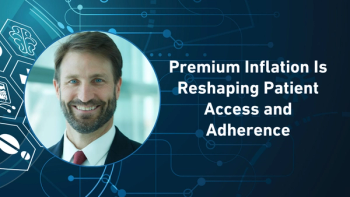
- Pharmaceutical Commerce - November/December 2017
Deloitte and Cardinal Health team up for patient support services
New IT platform modernizes the patient support data-gathering process
Fig. 1. Deloitte’s Patient Connect framework links various healthcare stakeholders with patient-care information[/caption]
“Patient support services,” as a business driver of the pharma commercialization, appears to be going in two directions these days: one in the chase for ever-better connection with patients by the pharma industry across the board; the other in deeper and more substantive connectivity in specialty pharmaceutical distribution and dispensing. The two goals are not in conflict, but they have different drivers: in the former case, the goal is to pull in more and more diverse data sets, such as those from social media; in the latter case, the need is to better coordinate activities originating with pharma companies (or their outsourced hub services providers), specialty pharmacies, health systems and physicians.
Now, a collaboration between two organizations: the ConvergeHealth business unit of Deloitte, and the Sonexus specialty-distribution business of Cardinal Health Specialty Solutions, have come together to bring some high-powered IT to the patient support problem in specialty pharmaceuticals. Cardinal Health has licensed (for exclusive use in outsourced hub services) the Patient Connect platform of Deloitte, added its own capabilities to it, and will market the result as the Sonexus ConnectSource platform. (Patient Connect has a variety of clients, including among health systems; ConnectSource will be offered exclusively by Cardinal to its clients for its specialty distribution services.)
“Sonexus has had a powerful IT platform in place for several years,” says Jennifer Fillman, VP and GM, Cardinal Health Specialty Services, “and we were looking to modernize it and to provide an ‘accelerator’ to speed up the overall patient support process. Patient Connect appealed to us because it could substantially cut our internal development time, and after we put it through its paces, it was the clear choice for partnering.”
Information technology platforms are a foundational resource for hub providers. The essence of a hub or patient support system is to bring together, coordinate and track a diverse variety of services necessary when many specialty pharmaceutical products are prescribed. Following a physician’s prescribing a drug to a patient, there is a need for a prior-authorization (PA) form to be filed with the patient’s insurer; then a benefits investigation/verification to line up financial resources. The drug (coming from a specialty pharmacy with its own patient support services) might be administered at specialized infusion centers or other clinics; it might also require pre- and post-testing for side effects. Nurse educators might be dispatched to the patient’s home for follow-up.
Adherence takes on special significance with many chronic-care or extended-regimen drugs, especially the highly expensive ones. The payer wants to ensure that an expensive treatment is being administered correctly, to improve patient condition and minimize future hospitalizations. The pharmacy and, to some degree, the pharma company, do not want abandoned scrips that generate no income for either. The health system is concerned with maintaining high adherence levels to meet federal and commercial-insurer expectations.
Deloitte’s ConvergeHealth business unit has spent the past several years developing a variety of IT platforms, and then performing analytics, per client request, on addressing a number of healthcare quality issues. “The key for hub services, and for patient support generally, is to coordinate activities around the therapy,” says Dave Rosner, a principal at Deloitte Consulting LLP who is managing the ConvergeHealth effort. “Many existing patient support systems have a proprietary design, and limit what data can be collected and analyzed. With Patient Connect, we’re providing an open platform into which other IT solutions can be linked, and offering dashboards and visualization to assist in the management of patient care.”
According to Deloitte, the trend toward improved patient engagement is driven by three key stakeholders:
- Patients, increasingly engaged and informed, are requesting health solutions that are coordinated, convenient, customized and accessible. Patients are using digital tools and technology to manage their well-being, and are starting to expect an “Amazon-like” customer experience when interacting with physicians, pharmacists and other healthcare service providers.
- Providers are interested in using healthcare data to gain deeper insights into the patient journey and to inform treatment decisions that lead to better outcomes—but accessing the necessary data and analytics is often a challenge.
- Pharmaceutical companies also want to understand the patient journey so they can develop effective programs to facilitate access to their products, drive medication adherence, deepen brand loyalty and help improve outcomes. But like providers, pharma companies are often frustrated by an inability to access the insights they need.
Patient Connect (and Cardinal’s version, ConnectSource) are cloud-based systems hosted by Deloitte. Patient Connect is also used by health systems (and there are activities going on to link it with health systems’ electronic health records (EHR) systems. Cardinal has tailored Patient Connect to its specific hub services and generally speaking, specialty pharmaceutical manufacturers who are Sonexus clients will be migrated to the system in the near future. A handful of pharma companies are already using it.
Both Fillman and Rosner see additional advances looming in their respective platforms. At Deloitte, Rosner sees the impact of value-based contracting, where health systems’ or pharma companies’ compensation is based on the outcome of the therapy. At Cardinal, Fillman sees the need to make real-world evidence available, both for quality assurance and for drug development. The opportunity presented by wearable medical devices, whose data can be transmitted to ConnectSource, is also being explored.
Articles in this issue
about 8 years ago
The changing paradigm in primary packaging of therapeutic proteinsabout 8 years ago
Traceability end-of-year updateabout 8 years ago
Big Pharma requires big help in protecting CRT productsabout 8 years ago
Pre-approval access and real-world evidence: a win-win propositionabout 8 years ago
Managing pharma auto fleetsabout 8 years ago
A conversation with Jim Cleary, AmerisourceBergenabout 8 years ago
If CVS Health-Aetna doesn’t happen, something else willabout 8 years ago
123 countries participate in Pangea X to fight counterfeit drugsabout 8 years ago
Bridging gaps in communicating with patientsNewsletter
Stay ahead in the life sciences industry with Pharmaceutical Commerce, the latest news, trends, and strategies in drug distribution, commercialization, and market access.




